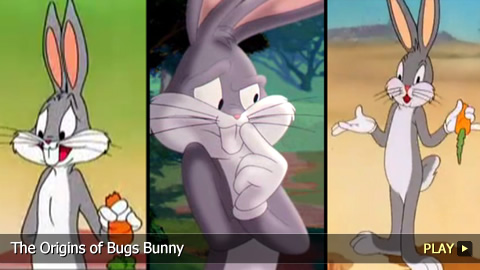The Origins of Bugs Bunny

He’s the carrot-munching rabbit with the white gloves who helped define the Golden Age of American Animation. Welcome to WatchMojo.com and today we’ll be taking a look at the origins of Bugs Bunny.
The character of Bugs Bunny was originally created in the late 1930s for Leon Schlesinger Productions by a team of animators that included Tex Avery and Chuck Jones. However, it was artist Robert McKimson who gave Bugs his definitive look and persona. In 1944, the production studio also underwent a significant change: after being acquired by Warner Bros., the studio became part of Warner Bros.’ cartoon division.
Starting with his first incarnations, Bugs was voiced by famed voice actor Mel Blanc. Bugs Bunny officially debuted in the 1940 Merrie Melodies short animation “A Wild Hare.” Bugs was a smart and rascally rabbit contending with a hunter.
This was not the studio’s first animation to feature the hunter-and-rabbit scenario: 1940’s “Elmer’s Candid Camera” featured prototypes of both Bugs Bunny and his dim-witted nemesis, Elmer Fudd. However, “A Wild Hare” was the first instance of Bugs showcasing his iconic voice and personality, as well as the official debut of Fudd.
That short also marked the first time Bugs used his iconic catchphrase. This quote paid tribute to a famous scene from the 1934 film, “It Happened One Night” where Clark Gable munched carrots and spoke with his mouth full.
At this point in Bugs’ career, the character was still unnamed. He remained so until his next outing, “Elmer’s Pet Rabbit.” In that short, he was named to pay tribute to director Ben “Bugs” Hardaway. He was one of the men responsible for the earliest inceptions of the cartoon rabbit, and he prompted the use of a famous Groucho Marx line within the series.
Bugs Bunny became an immediately popular character. His overwhelming success has been attributed to his calm and careless personality, charm and adorably innocent look. In fact, by 1942 Bugs became the most popular Merrie Melodies star, and he received special star billing.
His fame only increased through World War II when he confronted the likes of Adolf Hitler, Benito Mussolini and the Japanese. Bugs became the most profitable cartoon character produced by the company, and went on to star in 167 animated shorts.
After the war, Bugs began to appear in the Looney Tunes cartoon show, earned an Academy Award for Best Short Subject in 1958 and became the star of 1960’s “The Bugs Bunny Show,” which remained on television in syndication for over 50 years.
In 1988, Bugs appeared briefly in Disney’s hybrid live action film “Who Framed Roger Rabbit” alongside Mickey Mouse. However, Warner stipulated that Bugs and Mickey have equal screen time, right down to the millisecond, and this caused the cartoon rivals to enter and leave the picture together. Bugs later returned to appear opposite Michael Jordan in 1996’s Looney Tunes film “Space Jam.”
Aside from these many projects, the iconic bunny has appeared in various comics and video games.
In 2011, this iconic rabbit was introduced to a new generation of cartoon lovers in the series “The Looney Tunes Show.” As an unshakable mascot for Warner Bros. and its various divisions, Bugs Bunny has remained one of the most popular cartoon characters for over 70 years.
